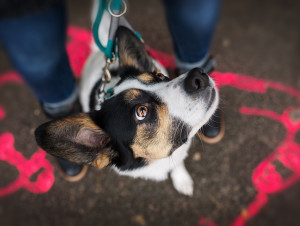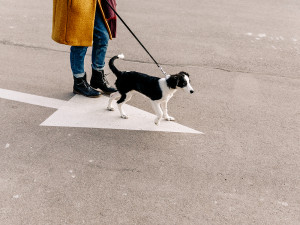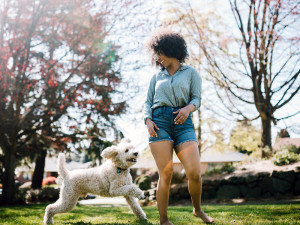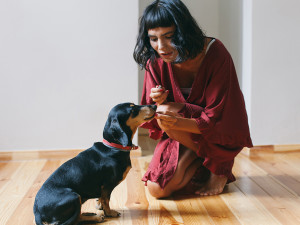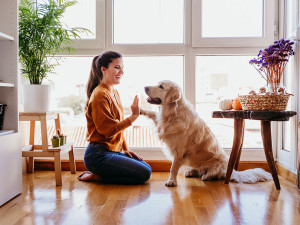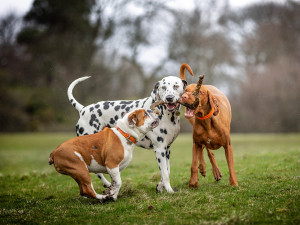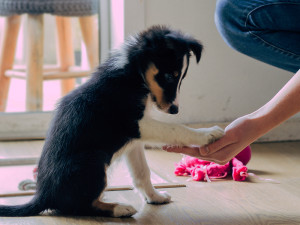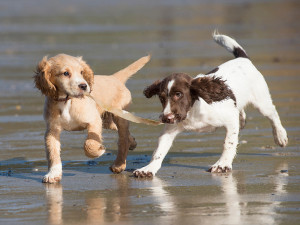Puppy Training 101: How to Train a Puppy
You gotta start somewhere.
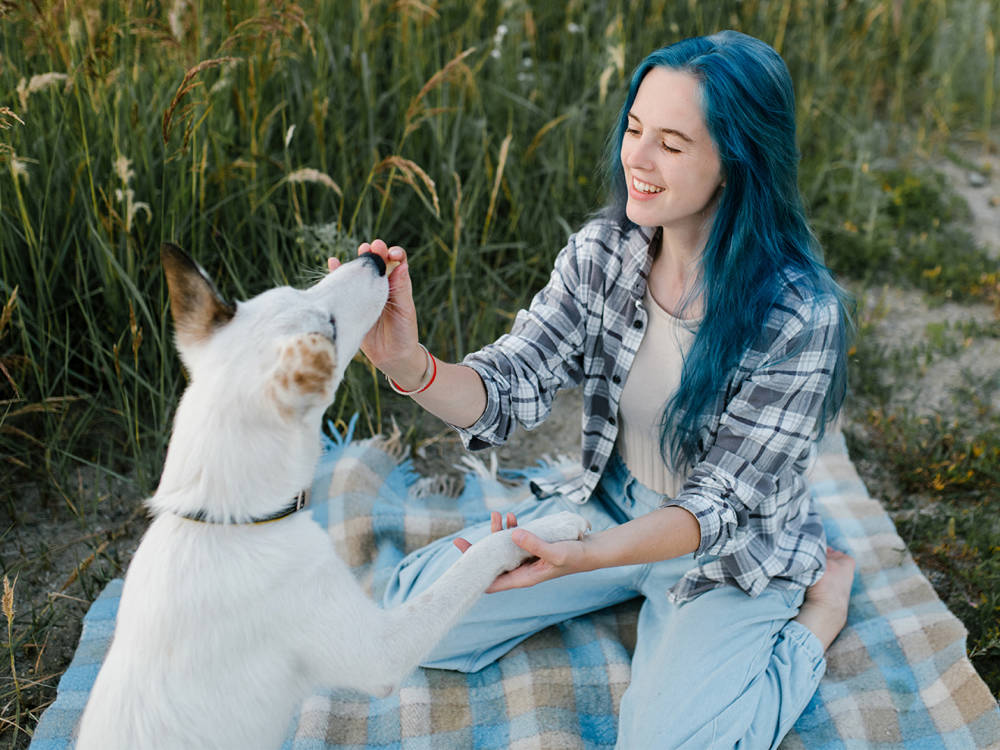
share article
Kick-starting a puppy training regimen can be a steep learning curve — often more so for you than your dog. The rise of virtual training sessions has been a godsend to many new pet parents, but for others in-class dog obedience training is a great place to start. Pick the method that is best for you and your pup. Keep reading for our Puppy Training 101 pro tips. (Heads up: We recommend a clickeropens in a new tab for this class.)
How to train a puppy
There’s nothing more fun than training a new puppy and watching them experience everything for the first time. Ready to get started? Here are your seven puppy training essentials:
1. Puppy-proof your home
If you give your pup free reign, you will regret it later, trust us. Before you start puppy training, set boundariesopens in a new tab early on to avoid breaking bad habits later. You can do this by puppy-proofingopens in a new tab your home: Keep countertops clear, cover trash cans, hide cords and cables, lock cabinets, and hide away shoes and other valuables away from puppy teeth. Baby gates can also help create a puppy-proofed labyrinth. Once they earn your trust, you can start taking down barriers.
2. Reward good behavior
With bad choices off the table, it’s time to teach puppy training obedience. That starts with positive reinforcement. Condition your pup to understand what behaviors you want them to repeat by rewarding them for their behaviors. Use a marker, like the word “yes” or the click of a clicker, to pinpoint the exact moment they do something you want to encourage. Then, taking a page from Pavlov, follow your marker with positive reinforcement (treats are your most valuable currency). Click, treat, repeat. In no time, your dog will practically be salivating the second they hear your mark. Pro tip: This method also works when training your puppy not to bite.
3. Teach them to focus
If you’ve ever zoned out during a Zoom call, then suddenly been called to answer a question, you know that winging it when caught off guard doesn’t always work. Likewise, when your dog is distracted, they aren’t going to perform well. Teaching them to focus on you and give you their full attentionopens in a new tab is an essential puppy training command.
Find a quiet area in your home, stand just as quietly (with treats ready and hidden), and simply wait for your dog to look at you. The second they do, give them a mark-and-treat one-two punch. When your puppy has figured out the power of a glance, you’ll be in for plenty of hungry stares. Once your dog masters this staring contest, try out this trick in places with more stimulation, like in your backyard. And so on and so forth.
4. Teach your pup leash manners at home
Your mouth waters watching restaurant commercials, so imagine how ravenous your dog feels when every walk is an olfactory buffet for their keen doggo nose. Walking at a heel calls for an incredible amount of self-control for a dog but is a must for your sanity and their safety.
Keeping outside distractions in mind, start leash training your puppyopens in a new tab at home. It’s not required, but you could get a puppy - leash — such as a well-fitted harness with a back attachment point that isn’t too restrictive. Leash them up, and tell them to sit parallel to you. Say “let’s go,” mark, and treat. Timing is everything! Every step that follows, so long as they stay by your side, should be rewarded. If — rather, when, because it will happen — your pups pulls, don’t chastise them; just stop, turn around, and wait for your dog to get the hint and check in with you. Again, once they get the hang of it, you can take it outside and practice IRL.
5. Train your dog to come when you call
Not to be dramatic but recall training can save your dog’s life. If you have a fenced-in yard, great. If not, use a 20-foot training leadopens in a new tab in a distraction-free zone. Pick a cue, either “comeopens in a new tab” or “here,” and start by saying it when your puppy is only a few feet away. When they come to you — you know the deal — mark and treat.
Gradually increase the distance by stepping back further and further, cueing your pup to follow. Having a dog who’s on-call means that you can trust them to swiftly return to you in case of emergency. For example, this could be when they get spooked and slip their collar on a busy street, or a fight breaks out in the dog park opens in a new taband you want them out of harm’s way.
6. Teach your pup to stay
Nailing the “stay” command ensures your dog’s (and your mail carrier’s) safety. Like a good true-crime series, it’s all about build-up, which just means telling your dog to stay, counting a few seconds in your head, then marking and treating before releasing them from the command with an “OK!” Put this routine on repeat, increasing the time before treating until you hit 30 seconds, then add some distance to the equation.
Once they’ve mastered the basic command, level up by walking in a circle around your dog, leaving the room or, the ultimate test, break out the vacuum cleaner. Don’t get frustrated if your pup snaps out of “stay” — this kind of mind control isn’t going to happen overnight. Trusting them to remain motionless until you give them the green light is a process, but one that’s worth it in the long run.
7. Desensitize them to being handled
The power of positivity isn’t just a self-help mantra, it’s also key for making your dog comfortable with you (and vets and groomers) handling sensitive body parts like paws and ears. Show your dog that they’re in good hands by pairing touch with treats. Gently hold your pup’s paw and give them a treat. You can eventually work up to a nail trimmeropens in a new tab — just not on day one. Baby steps.
How long does it take to see results?
Everything is a learning experience for dogs, but it’s a good idea to spend a few days a week dedicated to formal dog training. The ideal puppy training plan will depend on you and your dog. Some trainers find that shorter sessions are more effective than longer sessions. In a study on dog training frequency, researchers foundopens in a new tab that dogs trained one to two times a week learned a new behavior faster than dogs trained daily. Consistency and play trainingopens in a new tab also play big roles in how quickly dogs learn new behaviors.
Is it safe to train my puppy without professional help?
As long as you do your research, it’s safe to train your puppy without professional help. The caveat: You may not get the best results. Like anything in life, when you’re not an expert at something, it’s hard to do a good job. So it’s often a good idea to call a professional to help you out. Training a puppy is hard work, and getting help from a pro can save you a lot of time and frustration. It can also help prevent problem behavior from developing, such as marking in the house or chewing on clothes or body parts.
FAQs (People also ask):
1) What should be the first thing you teach a puppy?
The first thing you should teach your puppy is their name and recall (aka, to come when called). Both are skills that could save their life.
2) What is the hardest age to train a puppy?
Training a puppy is hard work no matter what age they are. That said, when your puppy is around three to four months, you might find it more difficult to train them because they may display nipping behaviors.
3) How old should a puppy be to start training?
As long as your puppy doesn’t have any health issues, you can start training them (including taking them to socialization classes) as early as seven to eight weeks old.
References
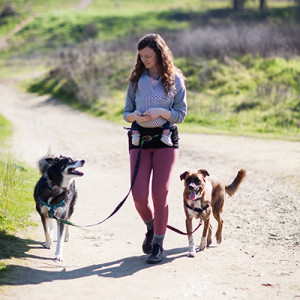
Tressa Fessenden-McKenzie, KPA-CTP
Tressa Fessenden-McKenzie, KPA Certified Training Partner and Family Paws Parent Educator, is the founder of Path and Paw and a training advocate on Dogly.
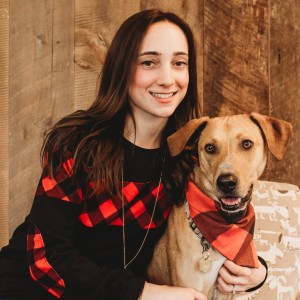
Danielle Vrabel, CPDT-KA
Danielle Vrabel is a dog trainer who earned her CPDT-KA in 2020. Danielle is a proud pet mom of five pets: two dogs, two cats, and a corn snake. Danielle has fostered over 10 dogs and 15 cats/kittens as well as helped train shelter dogs before they are adopted. Both of Danielle’s dogs are pet therapy dogs, where she also volunteers her time helping evaluate future therapy dogs.
Related articles
![woman gives small black dog treat for sitting]() opens in a new tab
opens in a new tabYour Dog Should Do This 30-Day Training Challenge
It’s like your 30-day yoga challenge — except with way more training treats.
![Boston terrier being stubborn]() opens in a new tab
opens in a new tabDog Training — DIY or Hire a Pro?
When it’s time to call in reinforcements.
![A woman holding a dogs paw and smiling.]() opens in a new tab
opens in a new tabNine Useful Tricks to Teach Your Dog
Go beyond the basics.
Are Dog Parks Good for Socialization?
Help! Should I take my young dog to the dog park for “socialization”?
![Border Collie puppy shaking owner's hand]() opens in a new tab
opens in a new tabWhen to Start Training a Puppy: a Complete Puppy Training Schedule By Age
Your puppy training schedule, from eight weeks to six months. Let’s do this.
![two small puppies play on a beach]()
Here’s Why You Need to Socialize Your Dog ASAP
Waiting until full vaccination to socialize can cause huge problems for your pup.
